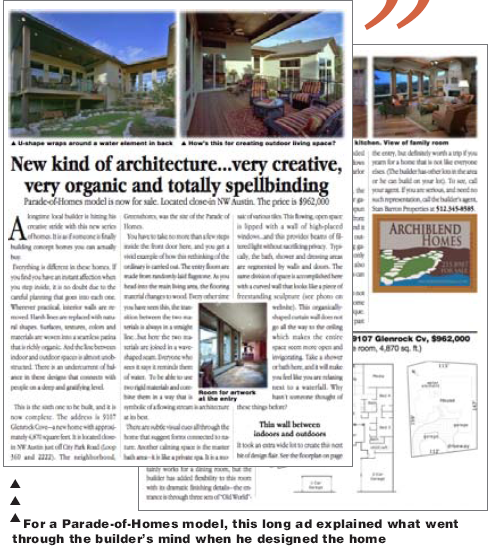This is the biggest mistake I see when I hear a home is not selling. Real estate agents and even builders try to use these ubiquitous “fact sheets” that typically include coma-inducing details such as the address, number of bedrooms, living areas, and the most mind-numbing statistic of all — the SEER rating of the HVAC system.
But it gets worse. As if it will somehow attract more attention, these flyers are often printed on bright-colored paper. This is the equivalent of driving by a business that has resorted to renting a giant, inflatable pink gorilla to place in the parking lot for a special weekend sale. Neither the flyer nor the gorilla is a dignified marketing method for selling anything.
Am I against flyers all together? Not necessarily. If you can turn your “traditional” flyer into a compelling story ad for a home—one that does a professional job of selling a high-end product, then you can use a flyer, or whatever you wish to call your ad for the home.
Are there better methods to sell homes than the “traditional” flyer? Absolutely. To get into step with more professional methods of selling homes, think about how other high-dollar items are advertised.
Consider what took place in the cosmetics industry several years ago. As retailers were stampeded into throwing up a website, they were faced with a problem: “How does a retailer create a website when it sells thousands of different items?”
What most did was to simply list the product name with a corresponding price. This did not sit well with perfume makers who rely heavily on the image created by the packaging, shape of the bottle, etc.
When the perfume makers saw their products reduced to a line item and a price, they quickly protested. They rightfully objected that this practice reduced their brands to a commodity, and it encouraged the consumer to make a decision based solely on who had the lowest price.
A similar objection is called for when a home is marketed with a flyer that simply lists the number of bedrooms and living areas along with a description of construction materials. This is important because even if you don’t sell “luxury homes” a house is still the largest purchase most will ever make.
If a marketing piece is allowed to boil a house down to its fundamental elements, then the house is reduced to a commodity.
A seller, builder, or architect may know all of the nuances that make a home special, but remember, the consumer will form an opinion based on the marketing material he is exposed to. If that information covers nothing but the basics, guess what happens? The consumer will migrate to a method of comparison that makes him feel secure and comfortable… the dreaded price-per-foot analysis.
How To Use A Professional Real Estate Ad,
Not A Traditional Flyer To Sell Homes
In Weeks Instead of Months
Here are six must-have keys to writing effective ads that sell homes in record time:
#1: Use a long ad
Testing shows that long ads sell better than short ads because long ads can educate the consumer as to what makes a product special or unique.
#2: Appeal to the reader’s self-interest
Should a company’s marketing state how long it has been in business? Is it a good idea to stress a builder’s dedication to quality and customer service? Or, how the sellers have diligently cared for the home? Doing so is a beginner’s mistake.
I heard a quote once from a successful copywriter who observed: “Customers respond when you give them information that appeals to their current belief system. Don’t tell them about you. Instead, explain how they will benefit.”
For example, the headline, “At last, here is a modern home on a large lot” has a much greater chance of stopping the reader than does, “Broughton Homes means quality you can count on.” Or the more pathetic example of: “Lovely Austin home that is move-in ready.”
#3: Tell an interesting story
The most difficult part of writing is getting started. To get the ball rolling, imagine the natural flow of conversation if a builder was at the jobsite when a customer stops to say, “I have been watching the progress of the house and really like it. What made you design the house the way you did?”
A builder would likely be flattered with such a question — and will not talk about the thickness of the insulation or the size of the water heater. Instead, he probably will talk about his vision for the house, describing what originally appealed to him about the lot. He may explain how he positioned the pool to catch the maximum amount of afternoon sunlight, etc. This process can produce fascinating insights that would have otherwise been missed. Here’s an example…
A well-known architect was interviewed about a house he designed. The house was on multiple lots and had a creek on the grounds. The house was not selling because of one recurring objection: the entire house was on one level, except for the master suite, which required going down steps to enter.
It was an objection until someone asked the architect to explain this seemingly odd feature. He used the steps to put the bedroom close to the creek so a person could open the windows and go to sleep to the sound of a running stream. The marketing was changed to reflect this insight, and the home quickly sold.
Story ads are low-key, but they deeply plant a sales message with consumers searching for unique homes.
Another example is a waterfront home that was not selling. The other houses on this waterfront street were perpendicular to the street, but this house was turned at an odd angle and did not look symmetrical. Then the builder explained what happened the first time he walked the vacant lot.
He noticed the lot was uniquely positioned where the lake made a sweeping turn. He realized that a V-shaped footprint, turned at just the right angle, would yield a long, booming view that spanned the length of the lake instead of merely looking across to the other side. This served as proof the home had the best view on the lake. When this story was used, the home received multiple, full-priced contracts.
Here’s an example ad that grabs a person’s attention with the unique element positioned in the headline:

(Click the image to download a PDF of the full ad example)
Builders and architects have a gift for visualizing in beautiful detail what the average person sees as a blank screen. The best way to describe this vision is to put it into the format of a narrative story.
Not selling a “new” home? Fine. Sellers will give similar unique details of their favorite part of their home, if you get them talking.
Use the approach explained in THIS VIDEO to get sellers talking (and writing your ad for you!).
#4: Strongest benefit goes in the headline
Five times as many people read the headline as they do the body copy, so put the most powerful promise in the headline.
As an example, a builder and his agent were frustrated by the lack of a sale on a perfectly good waterfront home. As often is the case, they were in competition with many other waterfront houses. A quick look at their marketing revealed the problem. What really made the house stand out was the size of the lot — this one was 12 acres — almost unheard of for a lake lot. But this fact was buried on page two of the flyer. The ad was rewritten to include this fact in the headline, in bold print, resulting in a sale in less than six weeks.
WARNING: You have to be careful. If a home has a view, don’t make this the theme of an ad IF many competing properties can match this claim. The rule is to put the home’s best claim — the one that others cannot easily match — in the headline.
#5: Give details that allow consumers to self-screen
Real estate agents love to withhold key facts like price, address or square footage to motivate a call. You do get more calls, but not more serious buyers. Ads work best when all of this key information is disclosed. Doing so attracts qualified inquiries. Also, provide a floor plan, site plan and locator map. Then you’ll know when you get a call, it’s because the person is truly interested and you won’t waste your time showing the property to lookee-loo’s.
#6: Think like a professional
This arguably comes at the beginning of the process of writing a great homes ad. But I’ve included it as my last tip, because I want you to REMEMBER to think of marketing as an investment.
Just for a moment, pretend there is a new reality show in which contestants compete to see who gets a chance to oversee the next issue of a Victoria’s Secret catalog. How long would the contestant last if he announced: “The quality of the merchandise is inherent in the lingerie itself, and everyone knows Victoria’s Secret makes a quality product. So, to save some money, I refuse to hire professional models or photographers. Some of the women here at the loading dock have agreed to model the underwear, and a friend of mine is pretty good with a camera. Also, my neighborhood QwikCopy will handle the printing because it is having a sale on lime-green paper.”
Does this reasoning sound absurd? It is, and unfortunately too often, builders compete to spend $400,000 on a lot to build a $1.5 million house only to refuse to spend $5,000 to market the finished home. For goodness sake, have the home professionally photographed and printed, on nice paper. It is not unreasonable to earmark 1 to 1.5 percent of the sales price for the marketing of a home.
The same is true of your typical seller who refuses to spend $1,000 on an ad to will sell their home in less than month. They’ll regret that mistake when they lower their price by at least $1,000 because their home is still on the market. It’s your job to sell homes, but also to educate sellers on how you’ll sell their home faster by using better marketing.
Click Here To View A Free Presentation Of
Stan Barron’s Unique Home-Selling Method
(It has more strategies about how to sell your listings faster.)









Leave a Reply